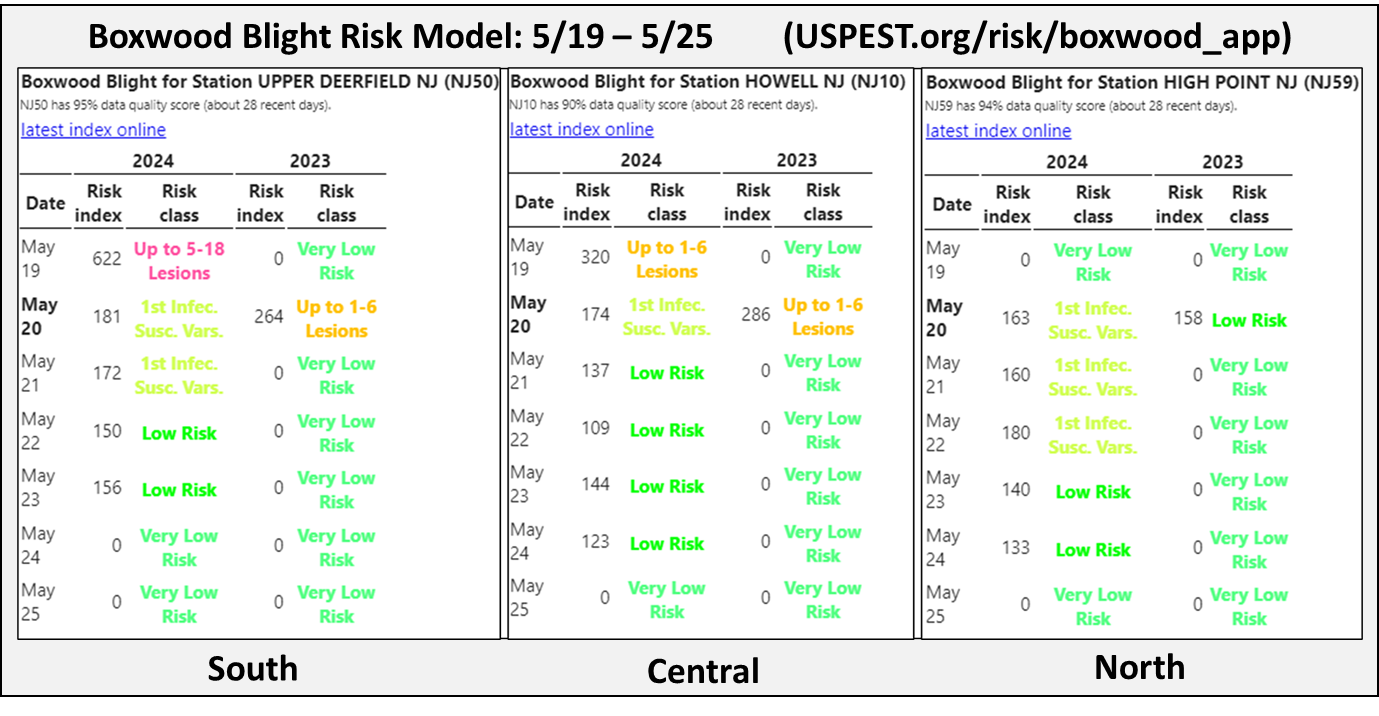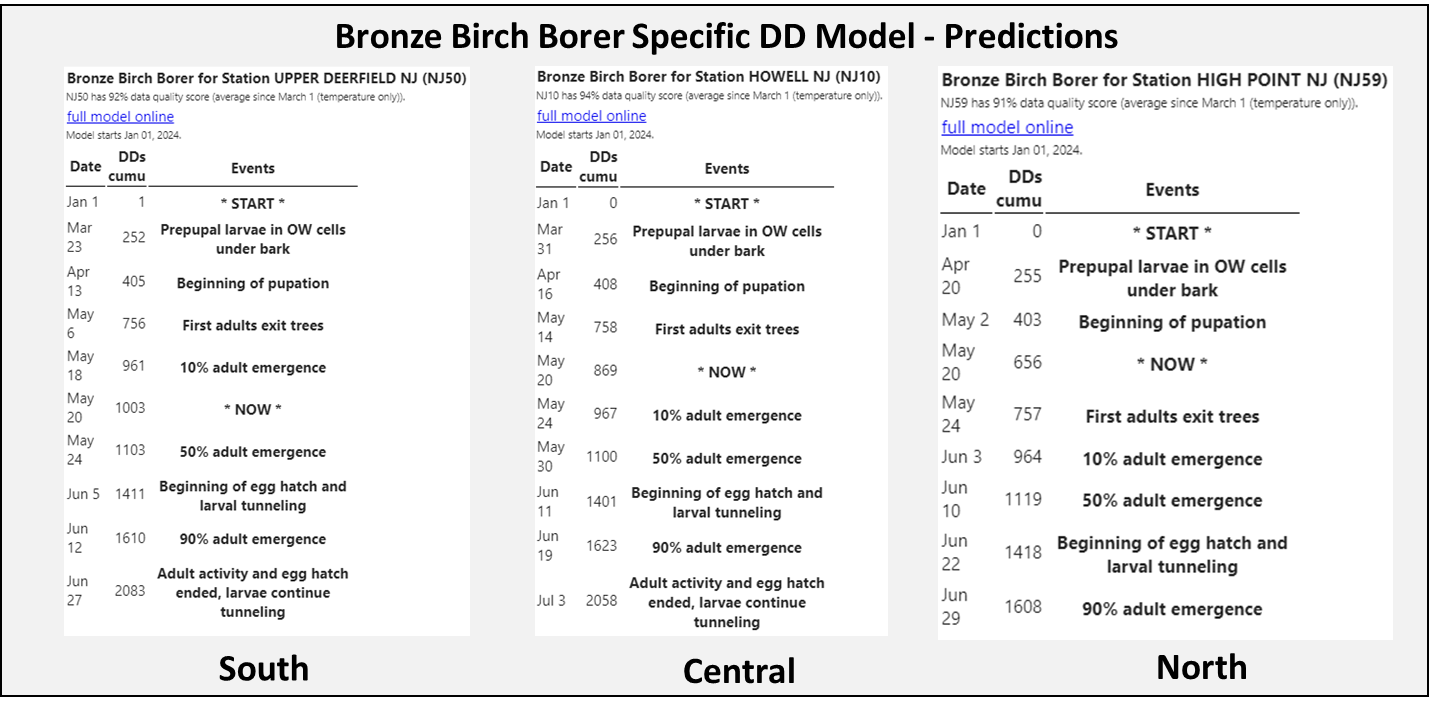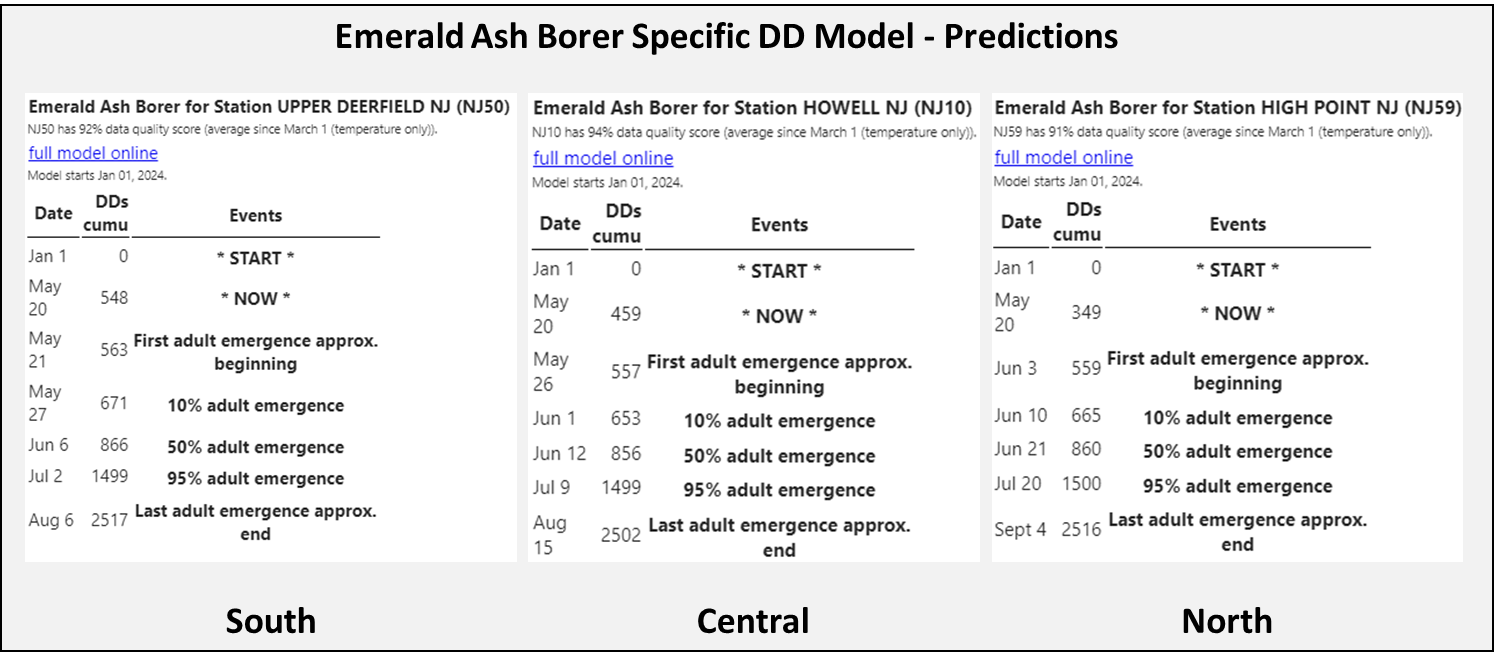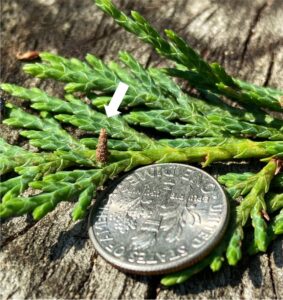Please note: The Rutgers Nursery and Green Industry Working Group is working to deliver regular pest and disease updates throughout the season. These will be in addition to important alerts, critical topics, and pesticide credit opportunities. This tool is made for you, the commercial agriculture business, so please let us know if there are particular topics you would like to see included in the regular update.
Email: twaller@njaes.rutgers.edu Phone: 856-451-2800 Ext. 1.
| Projected GDD50 accumulation as of 5/20/2024 (for June – July) | ||||||
| CODE | Location | 20-May | 1-Jun | 15-Jun | 1-Jul | 15-Jul |
| NJ50 | Upper Deerfield (South) | 437 | 658 | 957 | 1363 | 1766 |
| NJ73 | Vineland (South) | 454 | 670 | 961 | 1360 | 1755 |
| KMIV | Millville Airport (South) | 445 | 655 | 942 | 1338 | 1730 |
| NJ05 | Greenwich (South) | 453 | 681 | 984 | 1395 | 1798 |
| NJ10 | Howell (Central) | 344 | 545 | 809 | 1180 | 1554 |
| N59 | High Point (North) | 275 | 463 | 683 | 997 | 1316 |
| USPEST.ORG – Model: simple average/growing degree-day, Min: 50F – Max: 95F, NMME forecast | ||||||
| Forecast: 7-month NMME based seasonal climate forecast (USPEST.ORG) – Subject to change regularly = Check Often | ||||||
Please download and print the Rutgers Nursery and Landscape Pest Scouting Guide or Conifer and Christmas Tree Pest Scouting Guide and refer to this post “Obtaining your local growing degree-days (GDD)” for additional information. (See pest scouting guides for complete list of references)
Please SHARE what you SEE!! If you see a pest, disease, otherwise interesting or troublesome issue please report it to the Working Group by following the QR Code on the front of the Pest Scouting Guides or by filling out this reporting form.
Keep reading for more ALERTS – Red-headed flea beetle and Borer ADULT EMERGENCE, Boxwood Blight, bagworms
Red-headed flea beetle – Adult emergence
| Red-headed flea beetle – Predictions as of 5/20/24 | SOUTH | CENTRAL | NORTH | ||||||
| TARGET RANGE | Upper Deerfield (NJ50) | Howell (NJ10) | High Point (NJ59) | ||||||
| Growth Stage | Gen. | -LOW- | -HIGH- | LOW (DATE) | HIGH (DATE) | LOW (DATE) | HIGH (DATE) | LOW (DATE) | HIGH (DATE) |
| Egg hatch – larvae | 1 | 242 | 600 | 5/2 | 5/29 | 5/7 | 6/4 | 5/18 | 6/10 |
| Adults | 1 | 517 | 1028 | 5/24 | 6/18 | 5/30 | 6/24 | 6/4 | 7/2 |
| Egg hatch – larvae | 2 | 1570 | 1860 | 7/8 | 7/18 | 7/15 | 7/26 | 7/25 | 8/7 |
| (USPEST.org data compiled by Tim Waller – Cumberland RCE – Agent) | |||||||||
- Redheaded flea beetle adults will be or have started to emerge in NJ over the next 2 weeks.
-
Please refer to this RHFB materials and timing chart. Refer to the link for material considerations at various life stages.
Boxwood Blight Risk this week:
- Click here for current Boxwood Blight Risk Models
- Click here for the 4/10/24 boxwood blight ALERT with material considerations

Buprestid beetle / Flathead / Metallic Borer Specific models: (as of 5/20/24)


If borer insects are a common problem for your operation there are specific degree-day models made for Bronze birch borer and Emerald ash borer. You can set up these emailed alerts through the USPEST – PUSH Alerts for a multitude of pests and diseases. Contact twaller@njaes.rutgers.edu for assistance.
- click here for – Bronze Birch Borer (BBB) specific model (go to ‘Station’ and use your zip code)
- click here for – Emerald Ash Borer (EAB) specific model (go to ‘Station’ and use your zip code)
- More information on Clearwing Moth Borers in Pheromone Traps and Differentiating the Common Wood Borers of Ash Trees found here.
Bagworms – Should be on your radar

Days-old bagworm = critical management target – T. Waller – RCE
Bagworms should begin hatching NOW through – 4 weeks in NJ, beginning in the southern regions. Now is an optimal time to get this pest on your radar and prepare materials or approaches to attack first/second instar caterpillars. The control window for this pest is typically between 600-900 GDD50 when they begin to hatch and become airborne, i.e. the “ballooning” phase. It is important to check for egg-hatch prior to applications for greatest chemical efficacy, and to continue scouting as they often hatch and develop at asynchronous rates.
It is critical to target these insects EARLY!
Bagworm management – mechanical: If eggs have not hatched: hand-remove sacs/bags. Typically female/egg filled sacs are higher in the canopy so keep that in mind while scouting. This removes the problem from the field or landscape.
Treatment options for Lepidoptera (caterpillars) to have at the ready – containing: B.t. (Bacillus thuringiensis), spinosad , bifenthrin ), cyfluthrin, carbaryl, chlorantraniliprole, cyclaniliprole, cyclaniliprole + flonicamid, Lambda-cyhalothrin, cyantraniliprole, Indoxacarb. NOTE – Lethal pesticide doses are important, as sub-lethal doses can trigger early pupation, making the pest all but invincible to chemical or biological treatments. Follow label exactly.
IT IS CRITICAL TO ROTATE MATERIALS (Rotate between IRAC groups)
DISCLAIMER: The label is the law, always refer to it for allowable host crops, use-restrictions, application rates, reapplication intervals, re-entry intervals (REI), and mix compatibility information. Production and pesticide information on this site are for private/commercial pesticide applicators and landscape professionals only, and are NOT for home gardener use. Provided materials represent examples and do not cover all possible control scenarios. Please contact your local agent or chemical sales representative for more information or to discuss additional pest management options.
| BAGWORMS (600-900 GDD) (Bagworm hatch prediction as of 5/20/24) | ||||||
| Crop type | Common Name | Scientific Name | GDD Min (50F) | GDD Max (95F) | Reference | Developmental / Target Stage |
| Conifer mostly, many minor hosts | Bagworm | Thyridopteryx ephemeraeformis | 600 | 900 | RU | Larvae (early instars) – ONLY CONTROL WINDOW |
| Region | Location | Station | Date (600 GDD) | Date (900 GDD) | *Treatment window | *Bagworm Hatch – Predictions only, SCOUTING is critical! Treat as soon as larvae detected. |
| South | Upper Deerfield | NJ50 | 29-May | 12-June | 13 days | |
| Central | Howell / Freehold | NJ10 | 4-June | 19-June | 15 days | |
| North | High Point | NJ59 | 11-June | 26-June | 15 days | |
Other important insect pests: Scale crawler activity post forthcoming
Please download and print the Rutgers Nursery and Landscape Pest Scouting Guide or Conifer and Christmas Tree Pest Scouting Guide and refer to this post “Obtaining your local growing degree-days (GDD)” for additional information. (See pest scouting guides for complete list of references)

